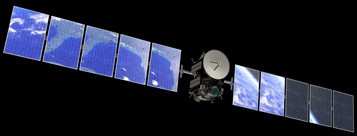Sun, Sep 02, 2012
Scheduled To Depart Vesta Asteroid September 5 On A 30 Month Journey To Ceres
NASA's Dawn spacecraft is on track to become the first probe to orbit and study two distant destinations to help scientists answer questions about the formation of our solar system. The spacecraft is scheduled to leave the giant asteroid Vesta on September 5 to start its 2 1/2-year journey to the dwarf planet Ceres.

Dawn began its 3-billion-mile odyssey to explore the two most massive objects in the main asteroid belt in 2007. Dawn arrived at Vesta in July 2011 and will reach Ceres in early 2015. These two members of the asteroid belt have been witness to much of our solar system's history. The valuable evidence Dawn gathered from examining the first of these cosmic fossils up close improved our understanding of asteroids and provided context for a future human mission to visit an asteroid.
The spacecraft will spiral away from Vesta as gently as it arrived, using a special, hyper-efficient system called ion propulsion. The ion propulsion system uses electricity to ionize xenon to generate thrust. The 12-inch-wide ion thrusters provide less power than conventional engines but can maintain thrust for months at a time. "Thrust is engaged and we now are climbing away from Vesta atop a blue-green pillar of xenon ions," said Marc Rayman, Dawn's chief engineer and mission director, at NASA's Jet Propulsion Laboratory (JPL) in Pasadena, Calif. "We are feeling somewhat wistful about concluding a fantastically productive and exciting exploration of Vesta, but now we have our sights set on dwarf planet Ceres."

Dawn provided close-up views of Vesta and unprecedented detail about the giant asteroid. Findings revealed that the asteroid had completely melted in the past, forming a layered body with an iron core. The spacecraft also revealed the collisions Vesta suffered in its southern hemisphere. The asteroid survived two colossal impacts in the last 2 billion years. Without Dawn, scientists would not have known about the dramatic troughs sculpted around Vesta, which are ripples from the two south polar impacts. "We went to Vesta to fill in the blanks of our knowledge about the early history of our solar system," said Christopher Russell, Dawn's principal investigator, based at the University of California, Los Angeles (UCLA). "Dawn has filled in those pages and more, revealing to us how special Vesta is as a survivor from the earliest days of the solar system. We now can say with certainty that Vesta resembles a small planet more closely than a typical asteroid."
JPL manages the mission to Vesta and Ceres for NASA's Science Mission Directorate in Washington. Dawn is a project of the directorate's Discovery Program, which is managed by NASA's Marshall Space Flight Center in Huntsville, AL.
(Images provided by NASA)
More News
Aero Linx: Model Aeronautical Association of Australia MAAA clubs are about fun flying, camaraderie and community. For over 75 years, the MAAA has been Australia’s largest fl>[...]
Touchdown Zone Lighting Two rows of transverse light bars located symmetrically about the runway centerline normally at 100 foot intervals. The basic system extends 3,000 feet alon>[...]
“Discovery and innovation are central to our mission at Virgin Galactic. We’re excited to build on our successful record of facilitating scientific experiments in subor>[...]
How To Get A Story On Aero-TV News/Feature Programming How do I submit a story idea or lead to Aero-TV? If you would like to submit a story idea or lead, please contact Jim Campbel>[...]
Student Pilot Reported That During Rotation, “All Of A Sudden The Back Of The Plane Kicked To The Right..." Analysis: The student pilot reported that during rotation, “>[...]
 ANN's Daily Aero-Linx (05.02.24)
ANN's Daily Aero-Linx (05.02.24) ANN's Daily Aero-Term (05.02.24): Touchdown Zone Lighting
ANN's Daily Aero-Term (05.02.24): Touchdown Zone Lighting Aero-News: Quote of the Day (05.02.24)
Aero-News: Quote of the Day (05.02.24) ANN FAQ: Contributing To Aero-TV
ANN FAQ: Contributing To Aero-TV NTSB Final Report: Cirrus Design Corp SR20
NTSB Final Report: Cirrus Design Corp SR20




